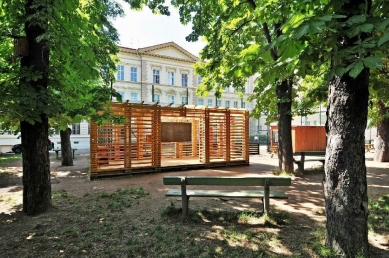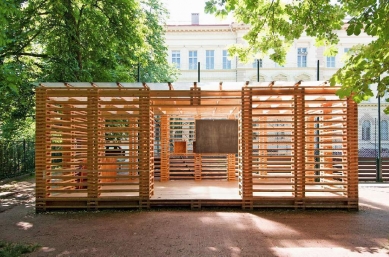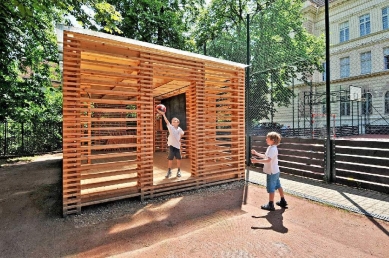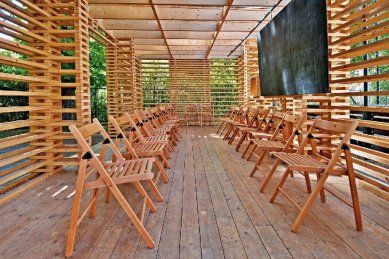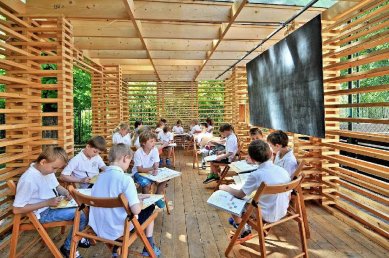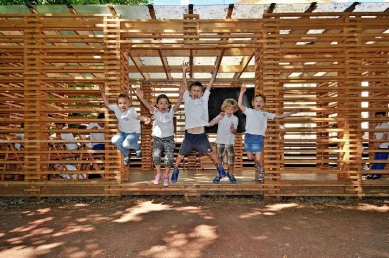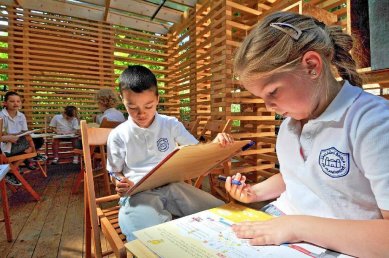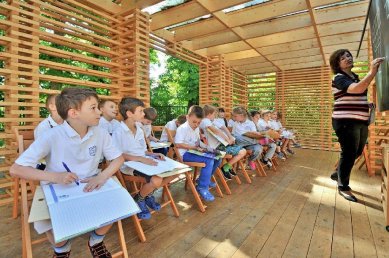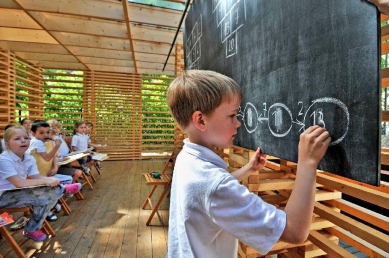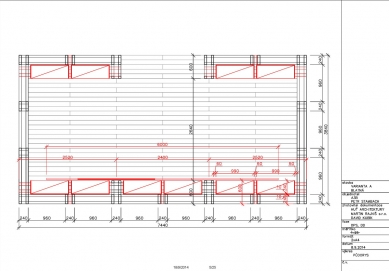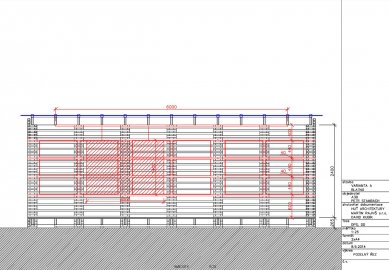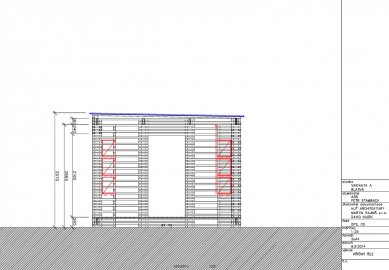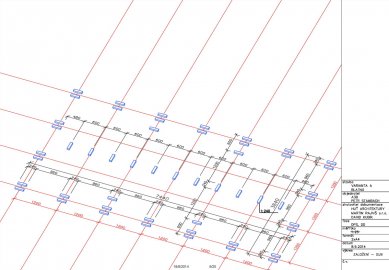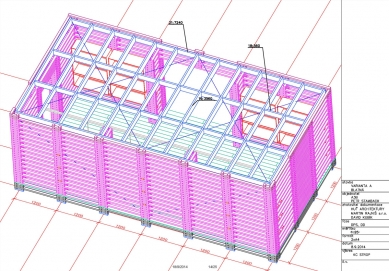
Outdoor classroom

Outdoor classrooms foster children's desire to learn
Outdoor classrooms are still a rare occurrence in Czech schools. However, their advantages are so apparent that they are gradually gaining more supporters. Those who try teaching outside, among trees and in fresh air, often return to it with enthusiasm. Especially when students can participate in the creation of their unconventional classroom.
The concept of outdoor teaching was introduced in 1926 by the renowned writer and archaeologist Eduard Štorch, who founded the so-called children's farm. According to his findings, outdoor teaching provided numerous advantages. Students were more relaxed and much more attentive. A similar experience was noted by Mgr. Jarmila Macečková, the principal of ZŠ Plamínkové in Prague, who liked the idea of building an outdoor classroom in the school grounds. “Teaching in classrooms situated to the east is very challenging, especially during warm weather. Therefore, the idea of building an outdoor classroom seemed very interesting to me,” says J. Macečková. The project was funded by the relevant municipal district, where the school administration found support for this initiative.
Children built their own classroom
The design of the classroom was created by architect David Kubík from the Huť architektury Martina Rajniše and Petr Štambach from the A3B studio, who came up with the idea and also manufactures the classrooms upon order. Implementing such a project was a challenge. “We wanted to design a wooden structure that would resemble the popular children's building set Kapla. Our aim was to bring the outdoor classroom closer to the children and awaken their interest in a new learning space. In children's play, you stack sticks of the same thickness on top of each other, cross them and arrange them. It’s simple, yet it creates an infinite number of variations and shapes. We created a wall structure that repeats in layers and is dimensionally variable by modules,” explains Kubík.
“Children helped during the construction with the carpenters, signed their names underneath the boards, and it was clear that they enjoyed it. Wood is close to people, and it is also a renewable resource. They could easily get involved and lend a hand,” adds Kubík. Another pleasant fact for the clients, according to him, is that obtaining a building permit for this type of construction is very straightforward, as it is designed to be self-sufficient, without connections to utilities. The entire project's implementation is therefore quick. The outdoor classroom has many advantages according to its users. The pleasant stay is not only in the summer heat, but the teaching continues throughout autumn and from spring to summer due to the classroom's popularity.
“The children really enjoy learning in the outdoor classroom. Teachers appreciate that students here are more open, communicative, cooperate better, and are more willing and open to speak,” specifies J. Macečková. According to her, the variability of the internal arrangement of lightweight wooden furniture is also beneficial for the outdoor classroom, allowing for easy organization of group teaching. Furthermore, there is a connection with the surroundings. The space has proven useful at ZŠ Plamínkové, for example, in foreign language teaching, where children communicate better and are more spontaneous.
For the construction of outdoor classrooms, planed spruce wood with rounded edges is used, treated with natural oil. The floor is wooden planks, the roof is made of safety glass, and the classroom is equipped with a large sliding board. Children sit on folding chairs, with an A3-sized plywood board on their laps. A larger entrance to the classroom can also serve as an outdoor theater for parents.
“The building does not require land preparation for foundations. It is based on oak beams, which are adjusted to the necessary height. There is also a version of the outdoor classroom with a solar panel or wind turbine, providing the classroom with electric energy for charging computers or connecting a projector. With a regular light bulb, students see a practical demonstration of modern energy management. A rainwater barrel can also be part of the classroom, so children have a place to wash the sea sponge for cleaning the board,” adds architect Kubík.
Outdoor classrooms are still a rare occurrence in Czech schools. However, their advantages are so apparent that they are gradually gaining more supporters. Those who try teaching outside, among trees and in fresh air, often return to it with enthusiasm. Especially when students can participate in the creation of their unconventional classroom.
The concept of outdoor teaching was introduced in 1926 by the renowned writer and archaeologist Eduard Štorch, who founded the so-called children's farm. According to his findings, outdoor teaching provided numerous advantages. Students were more relaxed and much more attentive. A similar experience was noted by Mgr. Jarmila Macečková, the principal of ZŠ Plamínkové in Prague, who liked the idea of building an outdoor classroom in the school grounds. “Teaching in classrooms situated to the east is very challenging, especially during warm weather. Therefore, the idea of building an outdoor classroom seemed very interesting to me,” says J. Macečková. The project was funded by the relevant municipal district, where the school administration found support for this initiative.
Children built their own classroom
The design of the classroom was created by architect David Kubík from the Huť architektury Martina Rajniše and Petr Štambach from the A3B studio, who came up with the idea and also manufactures the classrooms upon order. Implementing such a project was a challenge. “We wanted to design a wooden structure that would resemble the popular children's building set Kapla. Our aim was to bring the outdoor classroom closer to the children and awaken their interest in a new learning space. In children's play, you stack sticks of the same thickness on top of each other, cross them and arrange them. It’s simple, yet it creates an infinite number of variations and shapes. We created a wall structure that repeats in layers and is dimensionally variable by modules,” explains Kubík.
“Children helped during the construction with the carpenters, signed their names underneath the boards, and it was clear that they enjoyed it. Wood is close to people, and it is also a renewable resource. They could easily get involved and lend a hand,” adds Kubík. Another pleasant fact for the clients, according to him, is that obtaining a building permit for this type of construction is very straightforward, as it is designed to be self-sufficient, without connections to utilities. The entire project's implementation is therefore quick. The outdoor classroom has many advantages according to its users. The pleasant stay is not only in the summer heat, but the teaching continues throughout autumn and from spring to summer due to the classroom's popularity.
“The children really enjoy learning in the outdoor classroom. Teachers appreciate that students here are more open, communicative, cooperate better, and are more willing and open to speak,” specifies J. Macečková. According to her, the variability of the internal arrangement of lightweight wooden furniture is also beneficial for the outdoor classroom, allowing for easy organization of group teaching. Furthermore, there is a connection with the surroundings. The space has proven useful at ZŠ Plamínkové, for example, in foreign language teaching, where children communicate better and are more spontaneous.
For the construction of outdoor classrooms, planed spruce wood with rounded edges is used, treated with natural oil. The floor is wooden planks, the roof is made of safety glass, and the classroom is equipped with a large sliding board. Children sit on folding chairs, with an A3-sized plywood board on their laps. A larger entrance to the classroom can also serve as an outdoor theater for parents.
“The building does not require land preparation for foundations. It is based on oak beams, which are adjusted to the necessary height. There is also a version of the outdoor classroom with a solar panel or wind turbine, providing the classroom with electric energy for charging computers or connecting a projector. With a regular light bulb, students see a practical demonstration of modern energy management. A rainwater barrel can also be part of the classroom, so children have a place to wash the sea sponge for cleaning the board,” adds architect Kubík.
Klára Chábová
The English translation is powered by AI tool. Switch to Czech to view the original text source.
2 comments
add comment
Subject
Author
Date
tak to je super vec!
kakao
20.08.15 09:37
Čistá krása
Honza
19.06.20 11:27
show all comments


